Uncovering 10 Interesting Abandoned Buildings In Detroit
These Detroit abandoned buildings are perfect for urbex
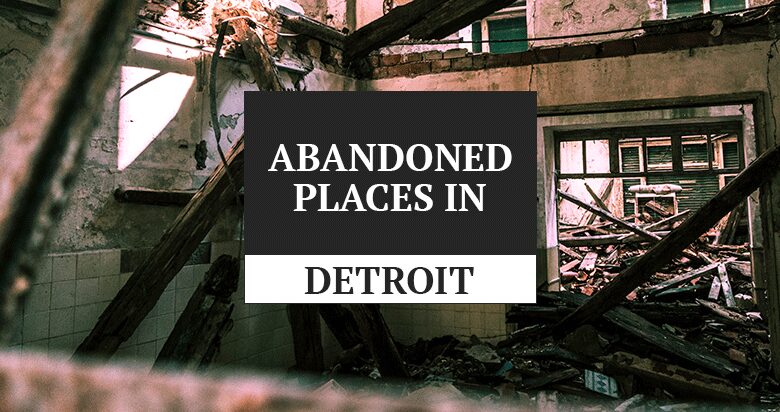
Since the 1960s the city of Detroit, Michigan has gone through a huge demographic and economic decline in recent decades.
With much of the steel and automotive industries in Detroit closing down, many residents were forced to move away to find better-paying jobs.
In the wake of the population decline, thousands of abandoned buildings in Detroit have been left behind to be reclaimed by nature.
Urban explorers from all over the world routinely visit our city to explore its famous abandoned buildings. Some take urbex tours, most prefer to do the exploring themselves.
If you were to visit the outskirts of Detroit you’d find nothing but decaying factories, deserted churches, and long-forgotten hospitals all of which still stand tall and mighty despite their crumbling exteriors.
If you’re an urban explorer or photographer in the Detroit area looking for abandoned places near you to explore, in this article I’ll share with you a handful of explore-worthy abandoned buildings that should be on your radar.
Best Abandoned Buildings in Detroit
1. St Agnes Church
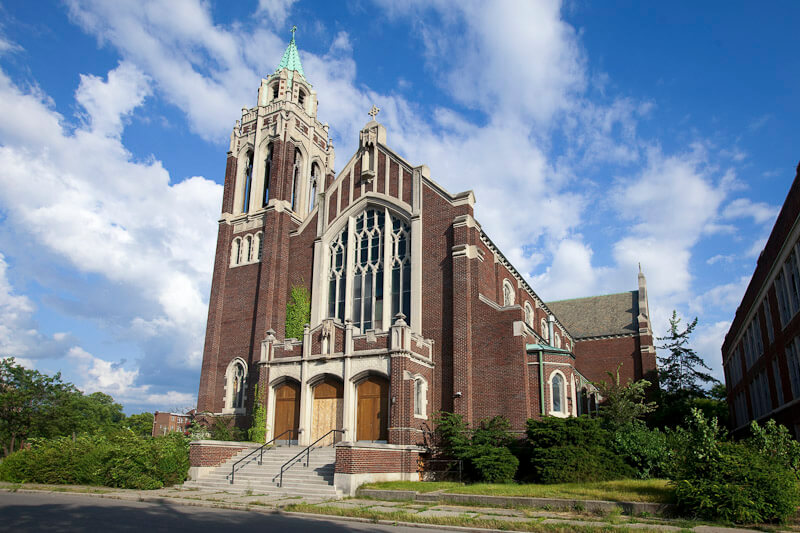
This long-standing Catholic church, located at 7601 Rosa Parks Blvd, was once a place of worship for thousands of families in Detroit.
At its peak, the church had 3 priests, 22 nuns, and over 150 students in the school adjacent to the church. For over 50 years St Agnes church flourished successfully, but things would change for the worse.
A police raid that took place in an after-hours establishment that was close to the church went wrong. The tension between the police and the locals grew into mass civil unrest.
Most of the buildings near the church were burned and badly destroyed. Remarkably, St Agnes church went relatively unharmed, but the community did not fully recover.
By 1985, the church saw less than 150 families attending worship at the church. The decline in attendants and the high cost of operations is what lead to its eventual closure.
In the 90s the church was set to be sold but the deal went to hell and the church was never sold. Since then it’s been sitting completely empty and forgotten. Vandals have stripped the church of any valuables.
2. Woodward Avenue Presbyterian Church
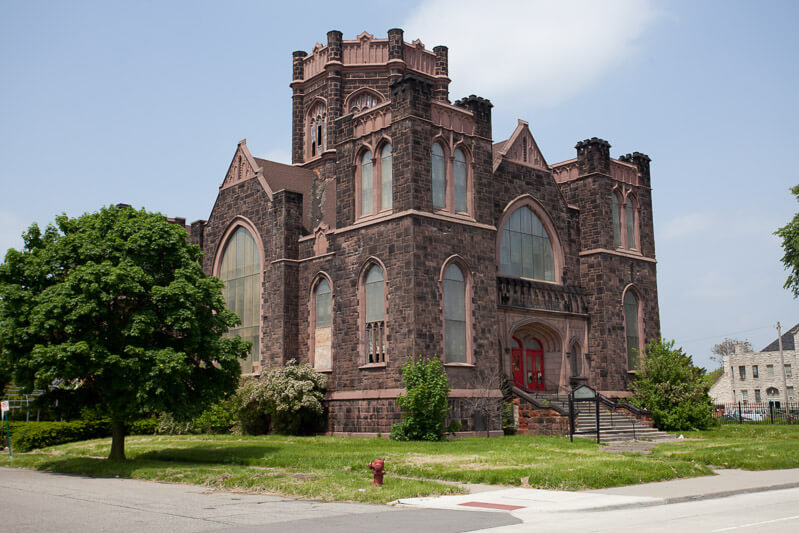
The origins of the Woodward Ave Presbyterian Church can be traced back all the way to 1907.
The church had a very modest beginning. A group of residents would meet in the basement of the home of a prominent member of the neighborhood.
After a while, the group started floating the idea of starting a church to serve the growing Presbyterian families moving into the area. A wealthy member donated a parcel of land to build the church on.
In 1911 what rose along Woodward Avenue was considered at the time a masterpiece of modern English Gothic design.
The church was designed with 2 square towers overseeing a gabled entrance carved in beautiful stone. Custom stained glass and precious stones were placed all over the church.
The church was constructed for a total of $100,00 ($2.6 million in today’s currency). At its height, the Woodward Avenue Presbyterian Church served as a place of worship for well over 1,000 families.
It included many different recreational and educational facilities such as a school wing where young students would meet.
In the late 70, membership at the church would reach its lowest in years. Attempts to save the church from closing down were made but in the end, were unsuccessful.
In 1993, the last reverend would step down and retired leaving the church with no leader. Since the 90s the Woodward Avenue Presbyterian Church would be abandoned.
Attempts to demolish it have been made but constant delays and high costs have stagnated any demolition plans. This church is on many explorers’ lists of abandoned places in Detroit to visit.
3. Detroit Children’s Zoo / Belle Isle Zoo
This zoo is one of my favorite abandoned buildings Detroit has to offer. Opened in the late 1800s the Detroit Children’s Zoo, found here on Google Maps, once held a unique assortment of wild animals.
For many years the zoo attracted thousands of attendants from all over the country. It housed tens of different animals both rare and common.
Monkeys, snakes, bears, tigers, and its most noteworthy was the herd of fallow deer that were native to the area but endangered.
In the 1980s Detroit’s Children’s Zoo went through an architectural theme change to bring in more visitors. The change failed and the zoo slowly fell victim to corruption and economic woes.
When it closed, the animals were shipped to different zoo’s all over the country. Most ended up in Indiana, but some made it as far as Washington. With time, the zoo was left empty and has been slowly being reclaimed by nature.
Attempts to revive the zoo were made in 2004, but the plans were scrapped and funds instead went to build an entirely new zoo.
4. Detroit Public School Book Depository
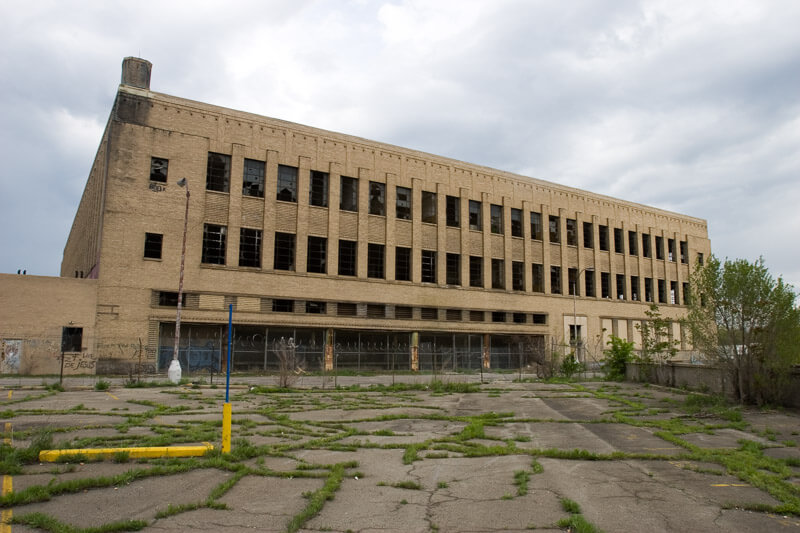
If you’re looking to do some urban exploration Detroit has many amazing places, like this one. Before the Detroit public school district took over the building, the book depository was a warehouse used by the post office.
In the mid-1900s the main post office was moved to a different more spacious building.
The Detroit public school district moved into the building to use it as a warehouse to store books and employee/student records.
In March of 1987, the depository building caught fire due to a possible arsonist. The fire caused millions of dollars in damage to school supplies and appliances.
Employees of the depository were forced to move into a new building until the depository was fixed, but that never happened.
In 2009 the building gained a bad reputation when a dead body was found in a flooded elevator shaft nearly covered in ice.
Local urban explorers, photographers, and graffiti artists have ventured into the building for years. Attempts to renovate have been made but are ongoing. Likely to never see any change.
Today it sits as one of the coolest abandoned places in Detroit to explore.
5. Trenton McLouth Steel Plant
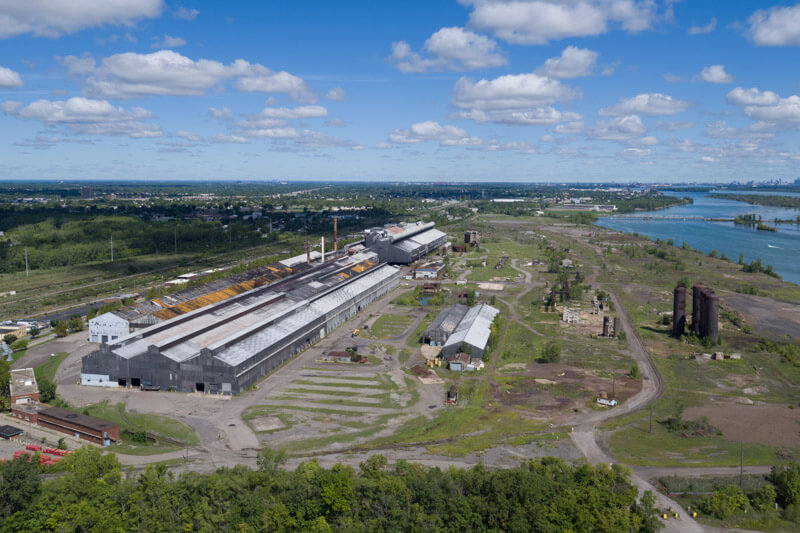
As Detroit’s automobile production began ramping up in the early 1900s, the need for locally produced steel led to the creation of the Trenton Mclouth Steel Plant.
Owned and operated by Donald B. McLouth, a serial steel mill owner in the Detroit area.
The Trenton McLouth plant, located at 1491 W Jefferson Trenton MI 48183, would go on to provide an uninterrupted supply of steel for Detroit’s growing automotive companies.
Several upgrades were made to the plant to expand capacity over the years. By 1962, McLouth employed over 3,000 workers but steel demand was on a steady decline.
The decline in steel demand and the fact that steel production is a dirty process that was damaging its environment led to its downfall.
By 1982 a wave of steel plants closing rolled through the area of Detroit. In 1995 McLouth steel plant would file for bankruptcy after years of profit loss and the high cost of maintenance.
The McLouth Steel Plant has been completely empty for nearly 2 decades. Most of its heavy machinery was removed before closing.
6. American Motors Corporation Headquarters
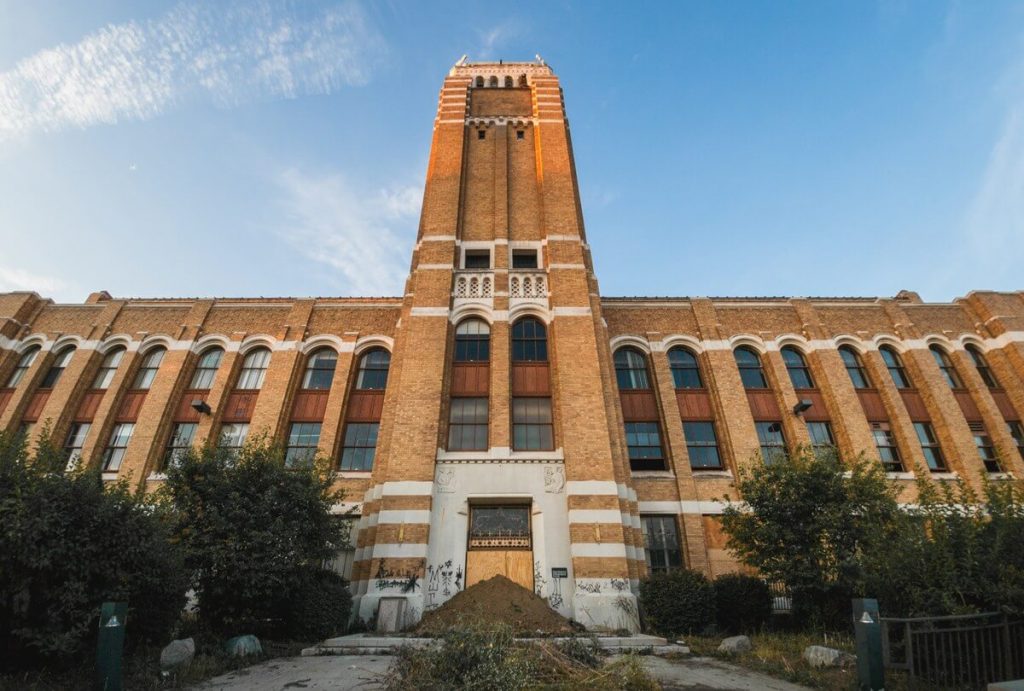
Here is another famous abandoned building Detroit is home to. Built in 1927, the 1.5 million-square-foot building started its life as a Kelvinator appliance factory.
The building was used to manufacture commercially available household refrigeration systems. During WW2 the factory was tasked with building helicopters for the army.
Over 250 helicopters were finished at the plant and also tested in a small airfield outback. The American Motors Company took possession of the factory in 1954.
AMC began to handle many different product lines from companies it had acquired. By 1960 AMC was producing and selling an estimated half a million cars per year from this factory.
In the early 1970s, AMC announced they would be moving operations to a new facility. This left thousands of workers unemployed and thousands more left the city due to rampant unemployment in the area.
It was sold in 2010 to a private businessman, Terry Williams, that was then arrested in 2012 for running an illegal automotive chop shop.
The building was seized by the government and has remained empty and abandoned since.
Today, the former AMC headquarters stands tall and mighty, a crumbling beacon of when Detroit was the main source of the US automotive industry.
7. The Brester-Wheeler Recreation Center
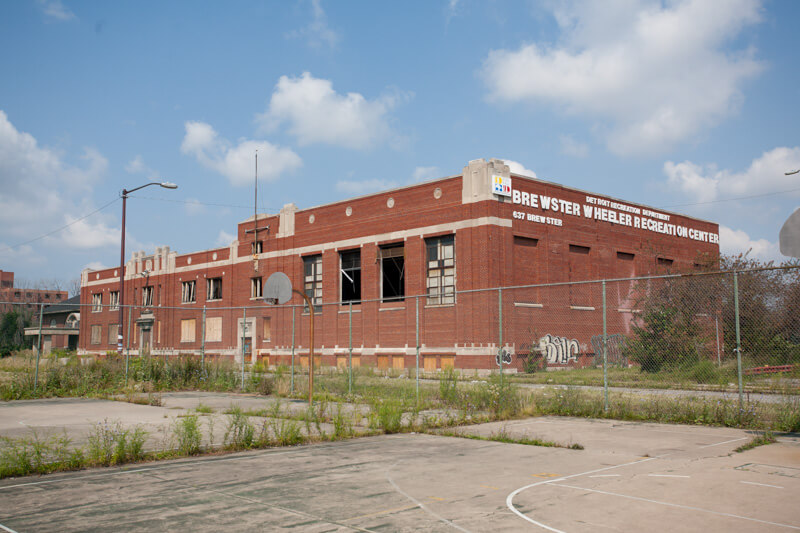
The Brewster-Wheeler Recreation Center got its start as a public library in its early days. Today it is one of the key abandoned buildings in Detroit to explore.
The library was opened in 1913 to serve impoverished children and adults in the slum immigrant neighborhoods outside of downtown.
The patronage at the library never reached expected levels and in May of 1928, the 11-year-old library was put up for sale.
On October 28th, 1929 the library was converted into an auditorium with seating and a stage for live performances.
It was renamed the Brewster-Wheeler Recreation Center and ran several rec programs including billiards, boxing, track, tennis, drama, dancing, and music classes.
World-famous boxer, Joe Louis, would get his early training in this very same center. In the 1930s, the area around the community center would see significant changes.
Federally funded housing projects for poor citizens would be built all around the center. Lack of maintenance and policing by the city officials would result in a decline in quality of life throughout the projects.
An increase in crime, drug use, and prostitution in the area would displace many residents.
Keeping the Brewster-Wheeler Center open was a challenge as the center relied on donations from its alumni to stay open.
Budget cuts year after year from the city and the low attendance is what would ultimately cause the center to close its doors in 2006. Since its closure, the center has been stripped of any valuables it contained.
Graffiti taggers have covered almost every inch of the building and several small fires would destroy parts of the upper floor of the building. The future of the Brewster-Wheeler is uncertain.
8. Fisher Body Plant 21
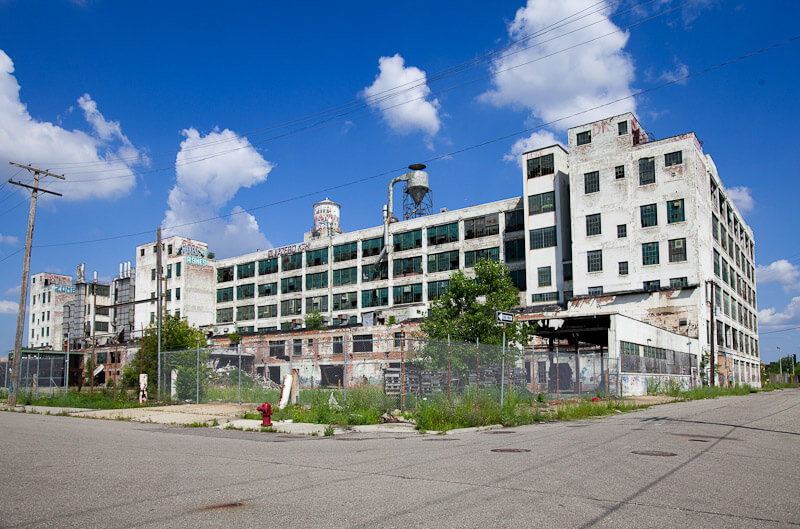
The Fisher Body Plant 21, located at 6051 Hastings St, Detroit, MI, was built in 1919 on Piquette Street in Detroit to meet the growing demands of the auto industry.
The plant served to turn out Buick and Cadillac bodies and focused on the stamping process of the build.
By 1920 Fisher was producing so many high-quality automotive body parts for several car companies including Cadillac, Ford, Hudson, and other big names.
A series of violent worker strikes would take place in the 1930s but things would calm down as the worker’s demands were met.
Like many automotive companies during the second world war, Fisher Body Plant 21 would stop producing auto body parts and instead focus on manufacturing components for planes, anti-aircraft guns, tanks, and many other materials.
After WW2, the plant would go back to stamping and assembling parts for buses and limousines. In 1982 General Motors announced it would close Fisher Body Plant 21 and move production to a new plant in Flint.
The plant was abandoned in 1984 but reopened in 1990 as an industrial painting factory. That didn’t last long as in 1993 the new owners filed for bankruptcy and abandoned the plant for good.
In 2008 the Environmental Protection Agency (EPA) began remediation work and removed several hazardous materials from the plant.
Asbestos, lead waste, cyanide, and thallium were all materials found and removed from the plant. If you decided to explore this plant, remember to wear a mask!
9. Northville Psychiatric Hospital
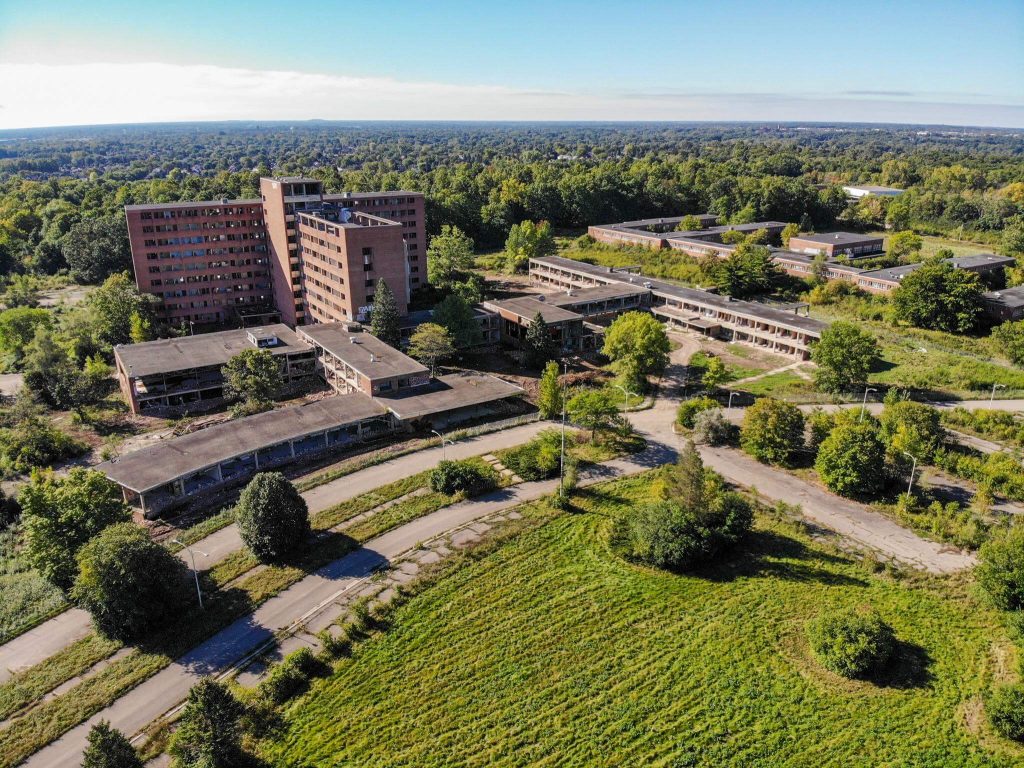
In the early 1940s, Michigan’s network of mental health hospitals was extremely overcrowded and inadequate.
A new mental hospital was needed to serve the needs of the mentally ill patients in the area.
An existing hospital for the ‘feeble children’ was taken over and renovated to serve as the new Northville Psychiatric Hospital for the mentally ill in 208 Lakewood St, Detroit, MI 48215.
The NSH consisted of 20 buildings in total. In its time it was lauded as one of the best psychiatric facilities in the country when it opened.
Patients suffering from varying degrees of mental illnesses would be treated in this hospital. The NHS itself was mostly self-sufficient.
It has its own kitchen, laundry, gym, movie theaters, swimming pool, and even a bowling alley.
All of the hospitals were also powered by a steam plant that supplied electricity and heat through a network of underground tunnels.
In the early days of Northville, doctors would pioneer the use of art and music as a way to treat ill patients. Patients would learn to play musical instruments, act in theater plays, study mechanics, economics, etc.
Due to budget cuts and severe overcrowding at Northville, doctors would begin relying more on drugs and sedatives to treat patients.
Northville Psychiatric Hospital was built to house 650 patients at a time. At its peak, over 1200 patients were living here. The Detroit News channel would call living conditions at the hospital ‘Appaling’ and ‘Sad’.
Some patients had to sleep in the halls and gym as rooms were not available. Assault, theft, racism, neglect, and rape were all common among the patients. several patients died while being treated at this hospital.
In 2003 the Northville hospital was finally closed. Two of the buildings were demolished but several still stand to this day.
Fences have been placed all around the property but that hasn’t deterred explorers from having a look inside. Today, the Northville Hospital is among some of the most popular abandoned buildings in Detroit to explore.
10. Continental Motors / Aluminum Plant
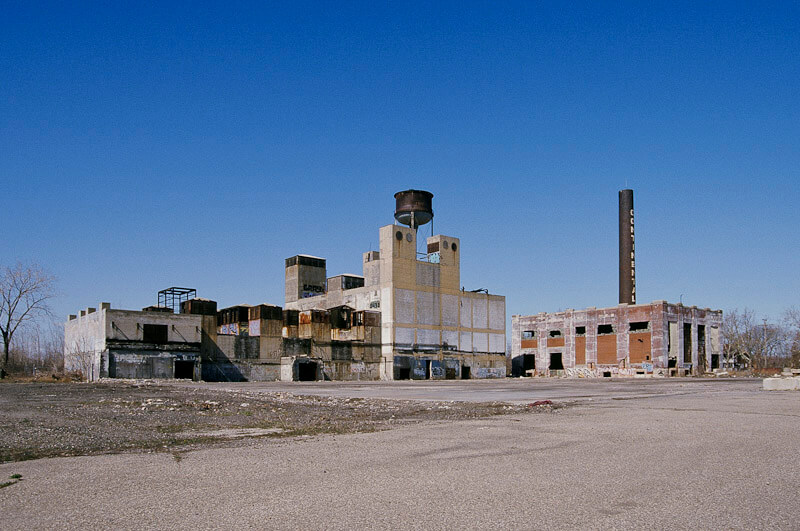
The Continental Motors company began when founding engineer, Ross Judson, invented a 2-cylinder engine.
As the engine grew in popularity, a second plant was constructed to cater to growing demand. A new plant was constructed along Jefferson Avenue on the east side of Detroit in 1911.
This new plant had the capacity to produce 20-22,000 thousand engines per year. For years Continental Motors dominated the automobile engine market supply.
They supplied motors to over 120 different manufacturers in Detroit alone. In 1930 the Continental Motors plant began producing aircraft engines and quickly became a major supplier for small aircraft manufacturers.
The Great Depression nearly wiped them out of business but they managed to stay afloat until the second world war came along.
In 1939, the plant stopped producing auto engines and instead worked on tank engines to supply the army. In order to test the tank engines, Continental Motors company decided to build a testing room on the north side of the plant.
Control rooms with blast-proof glass and super thick concrete rooms allowed the engineers to test the tank engines at full power.
In the post-war years, Continental Motors would see a drastic decline in engine demand. The company was sold in 1951 and it ran for 10 years before finally closing down. Parts of the plant have been demolished but still stand to this day.
Explore These Abandoned Buildings in Detroit Before They’re Gone
Whether you’re a photographer or an urban explorer, the many abandoned buildings Detroit has to offer will not disappoint.
The long history of economic hardships in Detroit ended with millions of residents fleeing the area and leaving thousands of abandoned buildings behind. Today some places in Detroit have become no-go zones with hundreds of houses and buildings left behind and deserted.
For many years, urban explorers have ventured into the famous city of Detroit to marvel at its decaying beauty. The owners of detroiturbex.com are some of them. For more abandoned buildings in Detroit, be sure to check them out.